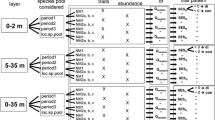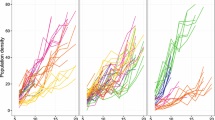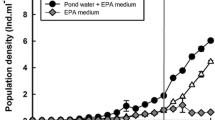Summary
We present data on polymorphism of the rotifer Keratella tropica from an outdoor, mesoscale experiment and a series of laboratory induction assays. In the outdoor experiment the biomass of planktonic crustaceans was noticeably depressed by larval fish predation, and associated with this depression K. tropica underwent a striking reduction of caudal spines. Subsequent laboratory studies showed that the positive association between crustacean biomass and caudal spine length was a cause and effect relationship. This is the first record of rotifer morphological change as an indirect effect of fish predation. In laboratory experiments filtrates of monospecific cultures of a cyclopoid copepod, a calanoid copepod and 5 cladocerans induced a remarkable spine development. Morphological induction showed a direct relationship with the concentration of crustaceans, both under field and laboratory conditions. Long spines were found to be strong deterrents against small predators (Acanthocyclops robustus copepodites), but were useless against large ones (females of the same species). The morphotypes of K. tropica obtained by experimental induction from a single clone encompass much of the worldwide variation of the species.
Similar content being viewed by others
References
Ahlstrom EH (1942) A revision of the rotatorian genus Keratella with descriptions of three new species and five new varieties. Bull Am Mus Natl Histol 80:411–457
Bottrell HH, Duncan A, Gliwicz ZM, Grigierek E, Herzig A, Hillbricht-Ilkowska A, Kurasawa H, Larsson P, Weglenska T (1976) A review of some problems in zooplankton production studies. Norw J Zool 24: 419–456
Burns CW, Gilbert JJ (1986) Direct observations of the mechanisms of interference between Daphnia and Keratella cochlearis. Limnol Oceanogr 31:859–866
Cassie RM (1971) Sampling and statistics. In: Edmondson WT, Winberg GG (eds) A manual on methods for the assessment of secondary productivity in fresh waters. Blackwell Scientific Publications, Oxford, IBP Handbook 17, pp 174–209
Dodson S (1989) Predator-induced reaction norms. Bio-Science 39:447–452
Downing JA, Rigler FH (eds) (1984) A manual on methods for the assessment of secondary productivity in fresh waters. 2nd edition, Blackwell Scientific Publications. Oxford, IBP Handbook 17
Dumont HJ, Van de Velde I, Dumont S (1975) The dry weight estimate of biomass in a selection of Cladocera, Copepoda and Rotifera from the plankton, periphyton and benthos of continental waters. Oecologia 19:75–97
Eloranta P (1982) Notes on the morphological variation of the rotifer species Keratella cochlearis (Gosse) s. 1. in one eutrophic pond. J Plankton Res 4:299–312
Gilbert JJ (1966) Rotifer ecology and embryological induction. Science 151:1234–1237
Gilbert JJ (1967) Asplanchna and postero-lateral spine production in Brachionus calyciflorus. Arch Hydrobiol 64:1–62
Gilbert JJ (1988) Suppression of rotifer populations by Daphnia: A review of the evidence, the mechanisms, and the effects on zooplankton community structure. Limnol Oceanogr 33:1286–1303
Gilbert JJ, Stemberger RS (1984) Asplanchna-induced polymorphism in the rotifer Keratella slacki. Limnol Oceanogr 29:1309–1316
Gilbert JJ, Waage JK (1967) Asplanchna, Asplanchna-substance and posterolateral spine length variation of the rotifer Brachionus calyciflorus in a natural environment. Ecology 48:1027–1031
Green J (1980) Asymmetry and variation in Keratella tropica. Hydrobiology 73:241–248
Green J (1981) Altitude and seasonal polymorphism of Keratella cochlearis (Rotifera) in lakes of the Auvergne, Central France. Biol J Lin Soc 16:55–61
Halbach U (1970) Die Ursachen der Temporalvariation von Brachinus calyciflorus Pallas (Rotatoria). Oecologia 4:262–318
Havel JE (1987) Predator-induces defenses: A review. In: Kerfoot WC, Sih A (eds) Predation: Direct and indirect impacts on aquatic communities. University Press of New England, Hanover, NY, pp 263–278
Hillbricht-Ilkowska A (1983) Morphological variation of Keratella cochlearis (Gosse) in Lake Biwa, Japan. Hydrobiology 104:297–305
Hutchinson GE (1967) A treatise on limnology. vol. II. Introduction to lake biology and the limnoplankton. John Wiley & Sons, Inc., New York
Lindström K (1983) Changes in growth and size of Keratella cochlearis (Gosse) in relation to some environmental factors in cultures. Hydrobiology 104:325–328
Pejler B (1980) Variation in the genus Keratella. Hydrobiology 73:207–213
Ruttner-Kolisko A (1977) Suggestions for biomass calculation of planktonic rotifers. Erg Limnol 8:71–76
Sokal RR, Rohlf FJ (1981) Biometry. 2nd edition, Freeman & Co, New York
Stemberger RS, Gilbert JJ (1984) Spine development in the rotifer Keratella cochlearis: induction by cyclopoid copepods and Asplanchna. Freshwater Biology 14:639–647
Stemberger RS, Gilbert JJ (1987a) Multiple-species induction of morphological defenses in the rotifer Keratella testudo. Ecology 68:370–378
Stemberger RS, Gilbert JJ (1987b) Defenses of planktonic rotifers against predators. In: Kerfoot WC, Sih A (eds) Predation: Direct and indirect impacts on aquatic communities. University Press of New England, Hanover, NY, pp 227–239
Threlkeld ST, Choinski EM (1987) Rotifers, cladocerans, and planktivorous fish: What are the major interactions? Hydrobiology 147:239–243
Voight M, Koste W (1978) Rotatoria. Die Rädertiere Mitteleuropas. Überordnung Monogononta. Gebr. Borntraeger, Berlin
Williamson CE (1983) Invertebrate predation on planktonic rotifers. Hydrobiology 104:385–396
Zagarese HE (1989) Predación por larvas de peces, particularmente de bagre sapo (Rhamdia sapo) y pejerrey (Odontesthes bonariensis) y sus efectos sobre las comunidades zooplanctónicas de agua dulce. Doctoral Thesis, Facultad de Ciencias Exactas y Naturales, Universidad de Buenos Aires, Argentina
Author information
Authors and Affiliations
Rights and permissions
About this article
Cite this article
Marinone, M.C., Zagarese, H.E. A field and laboratory study on factors affecting polymorphism in the rotifer Keratella tropica . Oecologia 86, 372–377 (1991). https://doi.org/10.1007/BF00317603
Received:
Accepted:
Issue Date:
DOI: https://doi.org/10.1007/BF00317603




